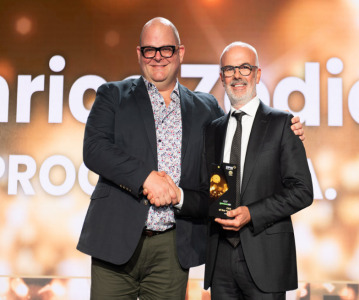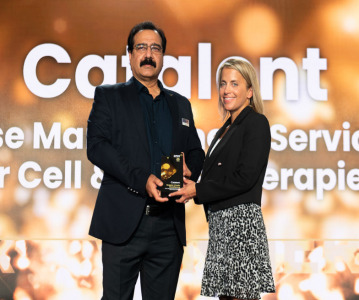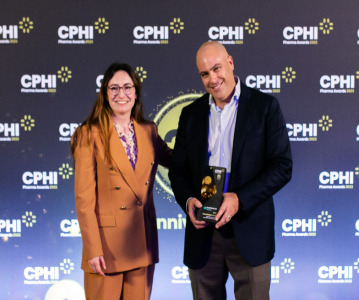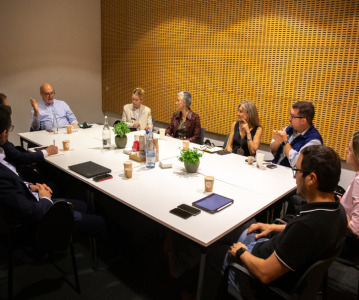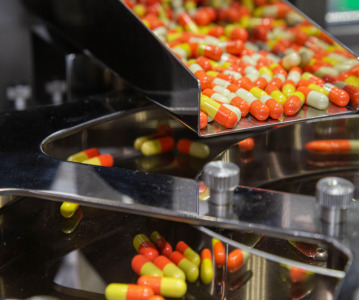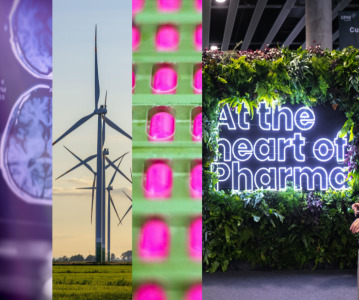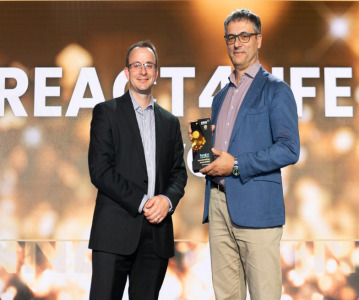CPHI Pharma Awards 2023 – Drug Delivery & Device Innovation Winners: Medicsen
.png)
After another year of impressive nominations for the CPHI Pharma Awards our winners were announced at CPHI Barcelona in October. In this series of interviews, we speak to the teams behind the award-winning projects, concepts, and technologies.
In this interview, Eduardo W. Jørgensen, CEO and Founder of Medicsen, tells us more about the Sonophoresis Smartpatch technology, the first needle-free and wearable drug delivery device, how the idea came about, and how it could revolutionise drug delivery for patients.
Please could you give a little bit of background to Medicsen and the aims and the goals of the company?
So I'm Eduardo Jørgensen. I'm a medical doctor by training, and in in 2014 I was in a hospital consult with a young girl with diabetes. She refused to keep injecting insulin because she was sick of using needles and because her friends laughed at her. She couldn't go on the field trips with the school, she couldn't have a normal life, and that shocked me.
I had wanted to become a surgeon, but that was a really shocking moment in my career, so I decided to try to build something that could solve these problems. We gathered a team of two technology engineers and two medical doctors to explore a non-invasive artificial pancreas, which evolved into our main innovation, and grew up to become the central piece of that potential device for the future.
But what we really invented was a way to deliver drugs through the skin without any kind of needles involved. We are using ultrasound to make that happen and the reason why this is innovative is because in spite of ultrasounds being known to increase the permeability of the skin since the 1950s, this feature has not been utilised to its full potential.
Normally, ultrasound devices need commercial level generators, which are very energy consuming.
So what we did was invent a miniaturised ultrasound transducer that can be powered with a traditional battery as well. This therefore enables a needle-free, patch-like device that can be adapted to a wide variety of different drugs.
In this journey, we've been able to advance up to a point of having been granted patents, we have a team of 16 professionals covering all the fields, we have a working prototype with positive evidence from animal trials in vivo, and now we're working to get the final device and start human trials as soon as possible.
Our next goals are raising around €5 million and achieving positive evidence in in vivo human trials and then licensing the technology to the pharma industry or medtech industry. In the long run, we want to be part of a movement to eliminate as many needles from the world as possible. Our goal is to, in 10 years by 2033, eliminate a billion needles from daily use of patients.
At the CPHI Pharma Awards, you won the prize for drug delivery and device innovation for your Smartpatch technology. Could you tell us a bit more about the technology?
Ultrasounds have been known for drug delivery, but is there was no commercial device. We had to start from scratch. In the very beginning, we did some rough tests with colour and molecules just to make sure that we could make the molecule go through the skin.
Once we had that, we started narrowing down the combination of frequencies, intensities, activations, and deactivations that were required to achieve that in an optimal way.
That required thousands of repetitions of in vitro tests. We jumped into in vivo trials, but in the meantime, one of the very first things that we had to do was selecting the technology with the goal of making drugs go needle free through the skin.
We didn't want to modify drugs because then you enter into different regulatory pathways and you have to adapt it to each and every single drug – we wanted to have a platform instead.
What we were able to achieve was a very good understanding that it's likely that ultrasounds are the only technology that can make that. We tried laser at the beginning but you need huge lasers. That cannot be authorised to work with devices and the actors cannot be miniaturised. They are still painful. For these devices, they don’t work with most of the drugs like insulin.
So, if we want to keep it non-invasive, we need to do something else, so once we had that we narrowed down the frequencies and intensities and after more in vivo trials we had confirmed all this, and we built a device around that technology.
So that has been our past in the last few years and the latest development was to turn the insulin device and give it platform capabilities to be adapted to different cases.
When you were developing the technology, did you come across any challenges as you were putting this together and how did you overcome them?
Yes, the first one was that we had invested a year of our time on laser technology and then we realised that it was never going to work. So we had to jump into ultrasounds and start basically from scratch. That was the first major barrier.
There's an endless cycle of needing money to produce results, but you need results to get money and the production of those results is fairly tricky because even though you develop your technology and you have some things to test about your technology, you're using standardised protocols and partners that can also add a level of risk to your analysis. So in our case, we had to repeat some of our trials because the HPLC machine failed on the analysis of the molecule.
Once we already had the samples after the delivery with our device and with our conventional device, we sent them for analysis and the analysis came back inconclusive. So we had to redo all the testing of the samples. Even if you plan for risks, it almost doesn't make any sense to plan that those type of things are going to happen, because then you have to have timelines and budgets that are infinite.
So the only way of overcoming it is planning - being very intelligent on the things that are likely to fail, planning ahead of time, and securing several different options for each of the things that you need to do and counting on, such as extensive budgets and timelines. We're not only building hardware; that is hard enough, we're building a type of medical hardware for drug delivery that has never been done before, so that kind of development brings significant challenges.
Could you explain in a bit more detail some of the advantages for the individual patients of technology like the smartpatch for that kind of therapy?
There's plenty of evidence, one is quality of life. If you have to prick yourself three times a day with a needle, you have a poor quality of life in most aspects.
But if you can just stick a patch on your skin and forget about it, have three programmed doses adapted to your needs so you don’t have to remember dosages and calculations, and not have invasive technology that's painful for you, it can increase the quality of life and if you increase quality of life for the patient then you increase adherence and you ultimately improve treatment results. That's like our basic set of a hypothesis and what we're pursuing there by eliminating needles from daily life of patients.
You have some additional benefits as well. You have a cartridge that can be loaded with the amount of drug that the patient is going to need for the period of time that they're going to wear it and you can preprogramme it.
You can tell a monitor you can control on dosage. For example, if you need to administer fentanyl or some highly addictive drug, you can control the maximum dosage per day that the patient's going to get. It's about comfort and reducing of pain and worry from the patient.
Then you also have benefits such as in reducing the patients' carbon footprint, which is something that a lot of chronic patients are worried about. If you need a pen injector every week of your life, what's the amount of waste that you're generating? In the end, our technology can be virtually sterile, so can be upcycled for secondary packaging and things like that. So it, it also adds additional layers of benefit for the patient and for the general population.
Accidental injuries with needles are among the top risks for medical practitioners. 2000 daily accidental injuries in the European Union it cost $3 billion every year. In terms of disposing of needles safely it's also a risk for sanitary workers because they're not disposed of safely at home.
Most patients just throw them away in the garbage, so that is also something where we will generate some sort of impact. Of course, these are secondary compared to patient comfort, but it's also really important.
What other things do you envision it being used for and do you think it could help with the treatment of rare diseases and things like that in the future? What aspirations do you have for the technology?
So the first one is for those patients that need a daily injection, which could be insulin, heparin, it could be teriparatide, which is an osteoporosis drug, where it adds additional layers of benefit as for example, this is a drug used in elderly patients, which usually can forget that they need to treat themselves. So if you can stick a patch on them, that's something that they don't have to remember. So that would be the first set of use cases.
Then we're also considering jumping into weekly or monthly deliveries like GLP ones that are booming right now. Or for growth hormone, and there are some in there that are interesting and our final target goal.
The Holy Grail is getting into monoclonal antibodies because the autoimmune therapies are going to keep growing. The drugs, like Humira, which are among the most sold in the world, patients still need to inject them in high volumes.
They're trying to make the patient go from the hospital to home for that kind of delivery. So we believe there's a real important niche in there, but we still have to prove that it can work with that kind of molecule.
What does winning the award at CPHI Barcelona mean to you and the company as a whole and how will it help the company?
This was a very important work for us, and by getting this award, we get a minute in front of a huge pharma audience, who are potential clients and partners. We need to get the word out. We need to be present in their minds when they're thinking about drug delivery devices for their drugs or their adaptations. This award in particular is the perfect platform for disseminating our message.
All these things really help small companies like ours to increase our reach and being able to access and to be positioned in front of the pharma industry. So we can start a conversation from there to contribute to our fundraising and our ongoing search for partners who have pilot drugs that our technology could be used with. It's a generator of opportunities and one we really appreciate it.
What can we expect to see in the future from Medicsen, do you have more technologies in the pipeline?
We want to grow the company. We want to become the Apple of medical devices doing some practical, beautiful tech, and improving quality of life for chronic patients.
We prefer to focus now on the patch. We believe that the same technology that we're using can be used for different products, but what we see now for the future is optimising the different generations of our device, making it thinner, more flexible, and more adaptable to different technologies. Also, understanding more the needs of the patient and the industry and putting them together. Our developments are going to move forward in that direction in the next decade. Up until we get that or we're close to that goal of a billion needles eliminated, from then on we expect to create new medical devices, new innovations in the area because that's what we like doing.
See more about the Medicsen Sonophoresis Smartpatch technology here.
Related News
-
News CPHI Pharma Awards 2023 – CEO of the Year Winner: Enrico Zodio, PROCOS S.P.A.
After another year of impressive nominations for the CPHI Pharma Awards our winners were announced at CPHI Barcelona in October 2023. In this series of interviews, we speak to the people and teams behind the award-winning projects, concepts, technologi... -
News CPHI Pharma Awards 2023 – Supply Chain Excellence Winners: Catalent Case Management Services
After another year of impressive nominations for the CPHI Pharma Awards our winners were announced at CPHI Barcelona in October. In this series of interviews, we speak to the people and teams behind the award-winning projects, concepts, and technologie... -
News CPHI Pharma Awards 2023 – API Development and Innovation Winners: Snapdragon Chemistry, a Cambrex Company
After another year of impressive nominations for the CPHI Pharma Awards our winners were announced at CPHI Barcelona in October. In this series of interviews, we speak to the teams behind the award-winning projects, concepts, and technologies. -
News Navigating the Future: Challenges and Opportunities in Pharma Innovation and Investment – CPHI Barcelona 2023 Roundtable Report
In this comprehensive downloadable report, hear from a range of experts in finance and investment in the pharma industry on what investment trends will be shaping the future of the industry, in Catalonia, and the wider world. -
News CPHI Barcelona 2023: Partnering for Success – Managing Outsourcing Relationships to Optimise Manufacturing Operations
During CPHI Barcelona 2023, insightful content sessions offered attendees the chance to explore trending topics with expert speakers and panellists. Here, we summarise what the pharma industry and supply chain are talking about the most. -
News CPHI Podcast Series: The 2023 Retro – what have we learnt from the past year in pharma?
Welcome to the last episode of 2023! Digital Editor Lucy Chard is joined by her teammates in a special retrospective episode to close out the year. Guests Vivian Xie, Editor for CPHI Online and Tara Dougal, Content Director for Pharma, discuss their hi... -
News CPHI Pharma Awards 2023 – Accelerating Innovation Winners: React4Life
After another year of impressive nominations for the CPHI Pharma Awards our winners were announced at CPHI Barcelona in October. In this series of interviews, we speak to the teams behind the award-winning projects, concepts, and technologies. -
News CPHI Pharma Awards 2023 – Regulatory & Compliance Winners: Lambda Therapeutic Research Ltd.
After another year of impressive nominations for the CPHI Pharma Awards our winners were announced at CPHI Barcelona in October. In this series of interviews, we speak to the teams behind the award-winning projects, concepts, and technologies.
Position your company at the heart of the global Pharma industry with a CPHI Online membership
-
Your products and solutions visible to thousands of visitors within the largest Pharma marketplace
-
Generate high-quality, engaged leads for your business, all year round
-
Promote your business as the industry’s thought-leader by hosting your reports, brochures and videos within your profile
-
Your company’s profile boosted at all participating CPHI events
-
An easy-to-use platform with a detailed dashboard showing your leads and performance
